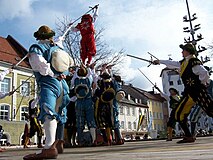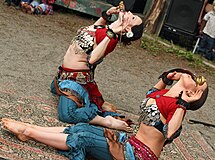|
Sword dance  Weapon dances incorporating swords or similar weapons are recorded throughout world history.[1] There are various traditions of solo and mock-battle (Pyrrhic) sword dances in Africa,[2] Asia[3] and Europe.[4] Some traditions use sticks or clubs in place of bladed weapons, while most modern performers employ dulled replications to avoid injury. FormsGeneral types of sword dance include:
China and Vietnam Sword dances in China and Vietnam, known as jian wu or múa kiếm, began as a military training exercise with swords and spears which evolved into an elaborate acrobatic dance.[8] Jian wu was one of four classical dances that were used in the Chinese and Vietnamese opera. Each of these dances was very meaningful within the opera performances and they often were used for plot descriptions and characterization.[9] Sword dancing also found a use in Chinese and Vietnamese cultures through communicating with the supernatural; sword dancing was done in an effort to communicate feelings to the dead spirits that may be disrupting a household.[10] There are quite a few styles within the actual art of sword dancing. The first style focuses on relaxation and flexibility while the other style focuses on speed and strength.[8] There are also different types of swords and weapons used during each dance. A long sword is usually wielded with slower dramatic movements during a solo performance while shorter scimitars are used at a very high pace during a sword dance between two or more people.[8] Each style requires certain movements that require the dancer to be highly agile and athletic. Indian subcontinent Many sword-dances in the Indian subcontinent originated with the martial traditions of the region, the paragon of which exemplified in the long-established Gatka tradition, arising from the tenet of monolithic, theosophical militarization found within Sikhism. The paika akhada which were previously used to train Orissan warriors now perform weapon dances in the streets during festivals. Other dances like the mer dandiya are simply theatrical depictions of battle, while some like the choliya of the Kumaon region were used to ward off evil spirits. Sword dances are still commonly performed for weddings and other occasions in the Indian subcontinent today. In the Indian subcontinent, the chhau sword dance,[11] Firkal sword dance,[12] Khasi tribal sword dance,[13] Bhotiya tribe sword dance,[14] Lakharu-li sword dance, Khaijama-Phanai sword dance, Gujarat sword dance and the Khattak sword dance are performed on festive occasions.[citation needed] Middle East Arab sword dances (raqs al-saïf) evolved out of sword fighting between men, in both Egypt and Turkey. There was even a time when sword dancing was banned by the sultan during Ottoman rule, as it was believed that dancers, who took swords from soldiers and pretended to "kill" them at the end of the performances, collected the swords to begin a resistance against the army. These swords were never returned. Female sword dancing was not widespread in West Asia. Men in Egypt performed a dance called el ard, a martial dance involving upraised swords, but women were not widely known to use swords as props during their dancing in public. However, paintings and engravings by French artist Jean-Léon Gérôme (who visited Egypt in the 18th century) show sword dancers balancing sabers on their heads. The Turkish Kılıç Kalkan dance of Bursa is performed exclusively by men with a sword and shield, and represents the Ottoman conquest of the city. The performers wear early Ottoman battle dress and dance to the sound of clashing swords and shields without music. EuropeHilt-and-point sword dances are, or were, performed all over Europe. These are particularly concentrated in an area corresponding to the boundaries of the Holy Roman Empire at around 1400–1500, and many of these traditional dances are still performed in England,[15] Czech Republic, Germany, Austria, North Italy, France, Flanders, and the Iberian Peninsula, with a particular concentration in Basque Country, Galicia and Andalusia.[16][17] Sword dances are also performed by Albanians, both in the Balkans and in Italy. Into the late 1400s Albanian sword dances were imitated by Italian tarantellas.[18] Sword dances performed by the guilds of Smiths and Cutlers in Nuremberg are recorded from 1350. 16th century records of sword dances survive from all over Germany. Depictions of dances survive from Zürich (1578) and Nuremberg (1600). In Scotland a dance was recorded as being performed in 1285, but this was found in a document from 1440. An important concentration of traditional sword dances can be found on the Italian side of the western Alps. Main sites are Giaglione, Venaus and S. Giorio in the Susa valley, where the so-called "Spadonari" (sword-holders) dance is still performed between the end of January and the beginning of February. This dance is also connected with the rebirth of nature and vegetation. In Romania, in a dance called Căluș, a sword dance similar to a Morris Dance, is part of a more complex ritualistic dance involving elements of fertility ritual and horse worship. Hilt-and-point sword dances traditional to England include rapper sword and long sword, although both of these are now also performed by revival teams outside their traditional areas, including teams in most of the English-speaking world. English sword dancing has also been brought to the New World, initially as part of the "morris revival" of the 1970s and 1980s. Teams are now extant in most major metropolitan areas in North America. The New York City Sword Ale is an annual gathering over Presidents' Day weekend that brings together over a dozen sword teams form the east coast and around the world. The Rugova war dance[19] (Albanian: Vallja me shpata e Rugovës or Loja Luftarake e Rugovës)[20] is a traditional Albanian war dance named after the Rugova region[21] in Kosovo. The dance is considered a relic of the war dances (Albanian: valle luftarake), the remnants of pantomimic dances performed in the re-enactment or preparation of battles.[21] The dance is performed by two male dancers who fight a mock battle for the hand of a girl (a "maiden's dance"[22]).[23] Gallery
See alsoLiterature
References
External linksWikimedia Commons has media related to Sword dance.
|







